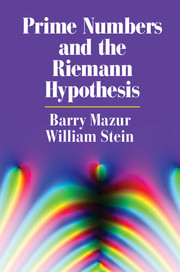Description
Prime Numbers and the Riemann Hypothesis
Authors: Mazur Barry, Stein William
This book introduces prime numbers and explains the famous unsolved Riemann hypothesis.
Language: English
Approximative price 61.26 €
In Print (Delivery period: 14 days).
Add to cart
Prime Numbers and the Riemann Hypothesis
Publication date: 04-2016
156 p. · 15.4x23.9 cm · Hardback
Publication date: 04-2016
156 p. · 15.4x23.9 cm · Hardback
Approximative price 27.70 €
In Print (Delivery period: 14 days).
Add to cart
Prime Numbers and the Riemann Hypothesis
Publication date: 04-2016
150 p. · 15.3x22.9 cm · Paperback
Publication date: 04-2016
150 p. · 15.3x22.9 cm · Paperback
Description
/li>Contents
/li>Biography
/li>
Prime numbers are beautiful, mysterious, and beguiling mathematical objects. The mathematician Bernhard Riemann made a celebrated conjecture about primes in 1859, the so-called Riemann hypothesis, which remains one of the most important unsolved problems in mathematics. Through the deep insights of the authors, this book introduces primes and explains the Riemann hypothesis. Students with a minimal mathematical background and scholars alike will enjoy this comprehensive discussion of primes. The first part of the book will inspire the curiosity of a general reader with an accessible explanation of the key ideas. The exposition of these ideas is generously illuminated by computational graphics that exhibit the key concepts and phenomena in enticing detail. Readers with more mathematical experience will then go deeper into the structure of primes and see how the Riemann hypothesis relates to Fourier analysis using the vocabulary of spectra. Readers with a strong mathematical background will be able to connect these ideas to historical formulations of the Riemann hypothesis.
1. Thoughts about numbers; 2. What are prime numbers?; 3. 'Named' prime numbers; 4. Sieves; 5. Questions about primes; 6. Further questions about primes; 7. How many primes are there?; 8. Prime numbers viewed from a distance; 9. Pure and applied mathematics; 10. A probabilistic 'first' guess; 11. What is a 'good approximation'?; 12. Square root error and random walks; 13. What is Riemann's hypothesis?; 14. The mystery moves to the error term; 15. Césaro smoothing; 16. A view of Li(X) - π(X); 17. The prime number theorem; 18. The staircase of primes; 19. Tinkering with the staircase of primes; 20. Computer music files and prime numbers; 21. The word 'spectrum'; 22. Spectra and trigonometric sums; 23. The spectrum and the staircase of primes; 24. To our readers of part I; 25. Slopes and graphs that have no slopes; 26. Distributions; 27. Fourier transforms: second visit; 28. Fourier transform of delta; 29. Trigonometric series; 30. A sneak preview; 31. On losing no information; 32. Going from the primes to the Riemann spectrum; 33. How many θi's are there?; 34. Further questions about the Riemann spectrum; 35. Going from the Riemann spectrum to the primes; 36. Building π(X) knowing the spectrum; 37. As Riemann envisioned it; 38. Companions to the zeta function.
Barry Mazur is Gerhard Gade University Professor of Mathematics at Harvard University, Massachusetts. He is the author of Imagining Numbers: (Particularly the Square Root of Minus Fifteen) and co-editor, with Apostolos Doxiadis, of Circles Disturbed: The Interplay of Mathematics and Narrative.
William Stein is Professor of Mathematics at the University of Washington. Author of Elementary Number Theory: Primes, Congruences, and Secrets: A Computational Approach, he is also the founder of the Sage mathematical software project.
William Stein is Professor of Mathematics at the University of Washington. Author of Elementary Number Theory: Primes, Congruences, and Secrets: A Computational Approach, he is also the founder of the Sage mathematical software project.
© 2024 LAVOISIER S.A.S.




